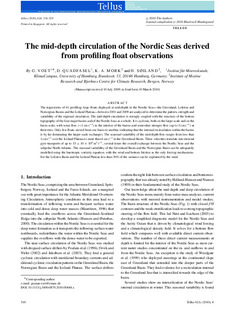The mid-depth circulation of the Nordic Seas derived from profiling float observations
Journal article, Peer reviewed
Permanent lenke
http://hdl.handle.net/11250/108390Utgivelsesdato
2010-08Metadata
Vis full innførselSamlinger
- Articles [3001]
Originalversjon
Tellus A, 62 (4), 2010: 516-529Sammendrag
The trajectories of 61 profiling Argo floats deployed at mid-depth in the Nordic Seas—the Greenland, Lofoten and Norwegian Basins and the Iceland Plateau—between 2001 and 2009 are analysed to determine the pattern, strength and variability of the regional circulation. The mid-depth circulation is strongly coupled with the structure of the bottom topography of the four major basins and of the Nordic Seas as a whole. It is cyclonic, both on the large-scale and on the basin scale, with weak flow (<1 cm s−1) in the interior of the basins and somewhat stronger flow (up to 5 cm s−1) at their rims. Only few floats moved from one basin to another, indicating that the internal recirculation within the basins is by far dominating the larger-scale exchanges. The seasonal variability of the mid-depth flow ranges from less than 1 cm s−1 over the Iceland Plateau to more than 4 cm s−1 in the Greenland Basin. These velocities translate into internal gyre transports of up to 15 ± 10 × 106 m3 s−1, several times the overall exchange between the Nordic Seas and the subpolar North Atlantic. The seasonal variability of the Greenland Basin and the Norwegian Basin can be adequately modelled using the barotropic vorticity equation, with the wind and bottom friction as the only forcing mechanisms. For the Lofoten Basin and the Iceland Plateau less than 50% of the variance can be explained by the wind.
Beskrivelse
Article published in Tellus Series A-Dynamic meterology and oceanography, 62 (4): 516-529 AUG 2010
